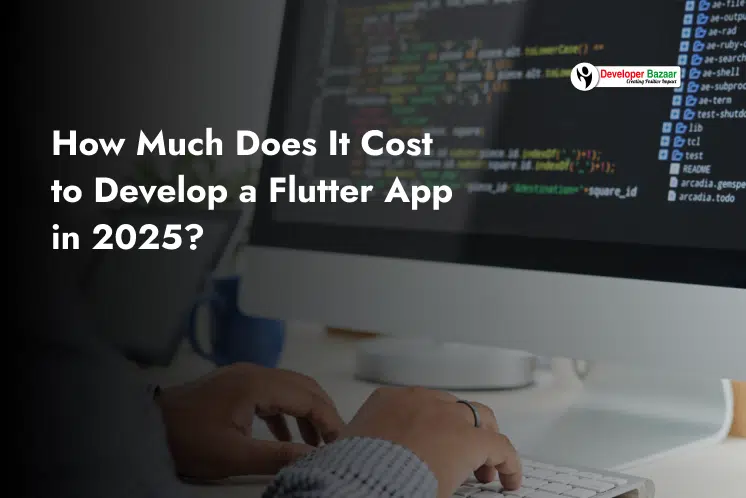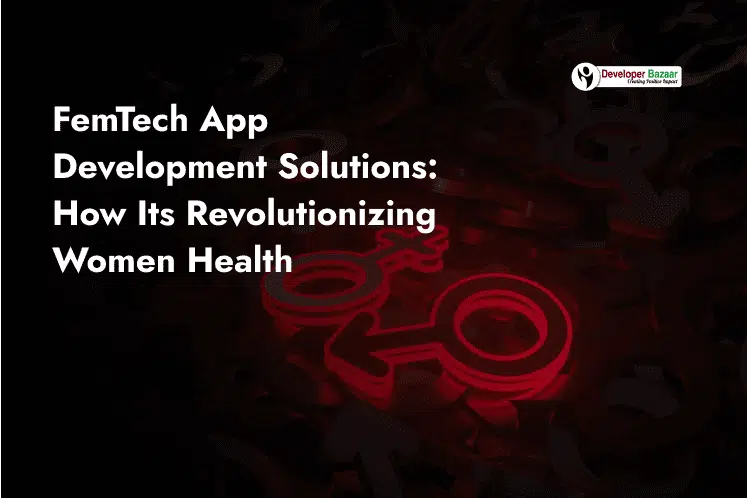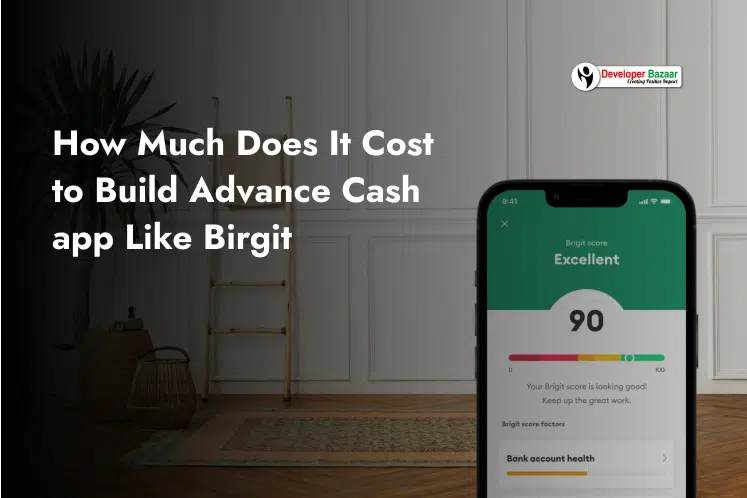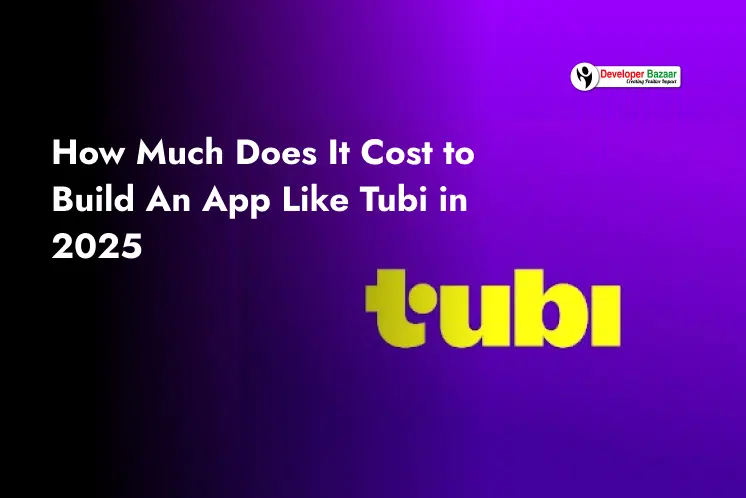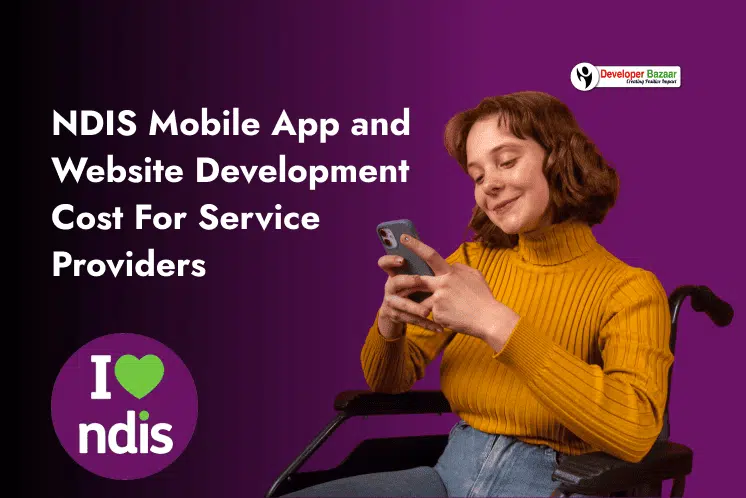Table of Contents
ToggleCross-platform mobile app development has become the cornerstone of modern digital strategy. With over 4.69 billion smartphone users in 2025 (Backlinko, 2025), businesses need efficient, cost-effective solutions to reach audiences across multiple platforms simultaneously.
Flutter has emerged as the leading cross-platform framework, fundamentally changing how companies approach mobile app development. Unlike traditional native development that requires separate codebases for iOS and Android, Flutter enables developers to write code once and deploy across multiple platforms, significantly reducing both development time and costs.
The Flutter framework has gained tremendous momentum in recent years. According to Stack Overflow’s 2023 Developer Survey, 46% of software developers actively use Flutter, making it one of the most popular cross-platform development tools available today.
Market Growth and Adoption:
- Flutter has over 170,000 GitHub stars, demonstrating strong developer community support
- Major brands including Google Pay, BMW, Toyota, and Alibaba have successfully implemented Flutter apps
- The global cross-platform app development market is expected to reach $120 billion by 2030, with Flutter capturing a significant portion of this growth
This comprehensive guide provides detailed insights into Flutter app development costs in 2025. You’ll discover accurate pricing estimates, understand key cost factors, learn proven cost-reduction strategies, and compare Flutter development expenses with traditional native approaches.
Why Choose Flutter for App Development in 2025?
Flutter’s popularity stems from its unique advantages that directly translate to cost savings and development efficiency. Understanding these benefits helps explain why Flutter development often provides superior return on investment compared to traditional approaches.
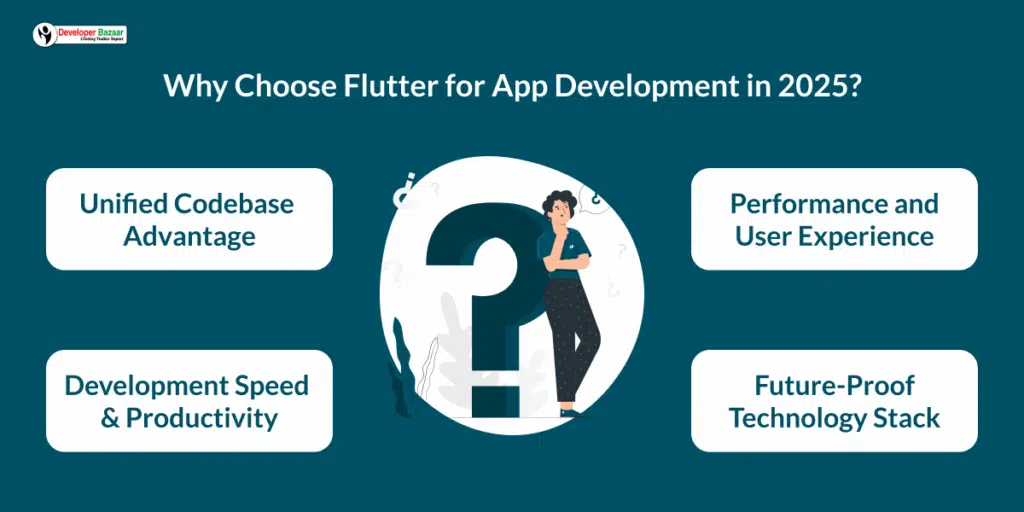
Unified Codebase Advantage
Flutter’s single codebase architecture eliminates the need for separate iOS and Android development teams. This fundamental difference reduces development costs by 40-60% compared to native app development while maintaining native-like performance across platforms.
Traditional native development requires:
- Separate iOS developers (Swift/Objective-C)
- Android developers (Java/Kotlin)
- Platform-specific testing and maintenance
- Duplicated UI/UX design work
Flutter development requires:
- Single development team using Dart programming language
- Unified testing and quality assurance process
- Consistent user interface across platforms
- Streamlined maintenance and updates
Performance and User Experience
Flutter compiles to native ARM code for both iOS and Android, delivering performance that matches native applications. The framework’s widget-based architecture enables pixel-perfect designs with smooth animations and responsive interfaces that users expect from premium mobile applications.
Key performance advantages include:
- 60 FPS animations and transitions
- Fast startup times comparable to native apps
- Efficient memory management and resource utilization
- Consistent user experience across different devices and operating systems
Development Speed and Productivity
Flutter’s hot reload feature allows developers to see code changes instantly without restarting the application. This capability dramatically accelerates the development process, reducing debugging time and enabling rapid prototyping and iteration.
Productivity Benefits:
- Hot reload reduces development time
- Rich widget library accelerates UI development
- Built-in testing framework streamlines quality assurance
- Comprehensive documentation and community support
Future-Proof Technology Stack
Google’s continued investment in Flutter ensures long-term viability and ongoing feature development. The framework now supports web, desktop, and embedded applications beyond mobile platforms, providing potential for code reuse across multiple deployment targets.
Average Cost to Develop a Flutter App in 2025
Flutter app development costs vary significantly based on project complexity, feature requirements, and development team location. Understanding these cost ranges helps establish realistic budget expectations for your mobile app project.
Flutter App Development Cost by Complexity Level
| Complexity Level | Development Time | Investment Range | Core Features Included |
|---|---|---|---|
| MVP Version | 2-3 months | $15,000 - $30,000 | Basic functionality, simple UI, essential features, basic backend integration |
| Standard App | 3-6 months | $30,000 - $80,000 | Advanced UI/UX, API integrations, user authentication, push notifications |
| Complex Application | 6-10 months | $80,000 - $150,000 | Real-time features, advanced animations, third-party integrations, analytics |
| Enterprise Solution | 10+ months | $150,000+ | Custom architecture, enterprise security, scalable infrastructure, ongoing support |
Detailed Cost Analysis by App Type
- Simple Flutter Apps ($15,000 - $30,000) : Simple applications include basic functionality apps like calculators, weather apps, or simple productivity tools. These projects typically require minimal backend infrastructure and focus on straightforward user interfaces with limited feature sets.
- Medium Complexity Apps ($30,000 - $80,000): Medium complexity applications incorporate features like user registration, payment processing, social media integration, and moderate backend complexity. Examples include e-commerce apps, social networking platforms, and business productivity tools.
- Complex Enterprise Apps ($80,000 - $150,000+): Complex applications feature real-time communication, advanced data analytics, custom animations, extensive third-party integrations, and sophisticated user management systems. These include fintech applications, healthcare platforms, and comprehensive business management solutions.
Flutter App Development Cost Breakdown
Understanding how development costs distribute across different project components helps optimize budget allocation and identify potential cost-saving opportunities.
Development Team Costs (60-70% of Total Budget)
- Frontend Development (30-40%): Flutter frontend development includes user interface design, navigation implementation, responsive design optimization, and platform-specific customizations. Frontend costs depend on design complexity, custom animations, and user experience requirements.
- Backend Development (20-30%): Backend infrastructure encompasses server architecture, database design, API development, user authentication systems, and third-party service integrations. Backend complexity directly correlates with app functionality and scalability requirements.
- Quality Assurance and Testing (10-15%) : Comprehensive testing includes functional testing, performance optimization, cross-platform compatibility verification, and security assessment. Proper testing prevents costly post-launch issues and ensures reliable user experiences.
Technology and Infrastructure Costs (15-25% of Total Budget)
- Third-Party Services and APIs: External service integration costs include payment processing (2.9% + $0.30 per transaction), cloud storage ($50-$200 monthly), push notification services ($200-$500 monthly), and analytics platforms ($100-$300 monthly).
- Development Tools and Licenses : Professional development requires various tools including design software ($20-$50 monthly per designer), project management platforms ($10-$30 monthly per team member), and testing devices ($2,000-$5,000 for comprehensive device coverage).
Ongoing Operational Expenses (10-15% of Total Budget)
- Cloud Hosting and Infrastructure: Cloud hosting costs scale with user base and feature complexity. Basic hosting starts at $100-$300 monthly for small applications, while enterprise solutions require $500-$2,000 monthly for high-availability infrastructure.
- Maintenance and Updates: Annual maintenance typically costs 15-20% of initial development investment and covers security updates, operating system compatibility, bug fixes, and minor feature enhancements.
Key Factors That Influence Cost
Multiple variables impact Flutter app development costs, and understanding these factors enables more accurate budget planning and cost optimization strategies.
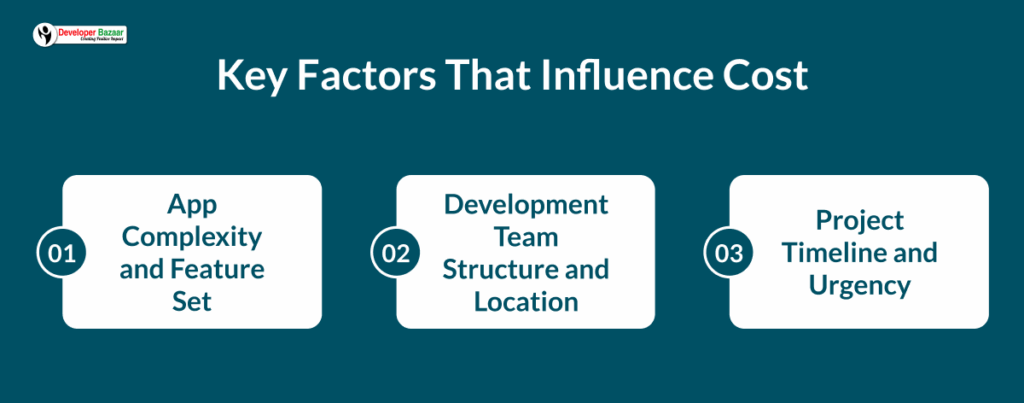
App Complexity and Feature Set
- User Interface Complexity: Custom animations, complex layouts, and sophisticated user interactions increase development time and costs. Simple, clean interfaces following Material Design or Cupertino guidelines cost significantly less than completely custom design systems.
- Feature Integration Depth: Basic CRUD operations cost less than real-time features like chat, live streaming, or collaborative editing. Advanced features requiring WebSocket connections, background processing, or complex state management increase development complexity.
- Third-Party Integration Requirements: Each external service integration adds development time and potential licensing costs. Popular integrations include payment gateways ($500-$2,000 setup), social media APIs ($200-$800), mapping services ($300-$1,000), and analytics platforms ($200-$600).
Development Team Structure and Location
- In-House vs. Outsourced Development: In-house development provides greater control but requires higher investment in salaries, benefits, and infrastructure. Outsourced development offers cost flexibility and access to specialized expertise at different price points.
- Team Size and Expertise Level: Senior developers command higher rates ($80-$150/hour) but often complete projects faster than junior developers ($25-$60/hour). Balanced teams combining senior and mid-level developers optimize both cost and quality.
Project Timeline and Urgency
- Standard vs. Accelerated Development Rush projects requiring extended hours or additional resources increase costs by 25-50%. Planning adequate development time allows for better resource allocation and cost optimization.
- Market Launch Timing Seasonal product launches or competitive timing pressures may require additional resources or expedited development processes, impacting overall project costs.
Flutter App Development Cost by Region
Geographic location significantly influences development costs while maintaining comparable quality standards. Understanding regional variations helps optimize development budgets and team selection.
North America (United States, Canada)
- Hourly Rates: $80-$180 per hour
- Project Costs: $60,000-$200,000 for standard applications
- Advantages: Native English communication, timezone alignment, established legal frameworks
- Considerations: Higher costs offset by reduced communication overhead and project management complexity
Western Europe (UK, Germany, Netherlands)
- Hourly Rates: $60-$120 per hour
- Project Costs: $45,000-$150,000 for standard applications
- Advantages: High technical expertise, strong English proficiency, GDPR compliance experience
- Considerations: Moderate cost savings with maintained quality standards
Eastern Europe (Poland, Ukraine, Romania)
- Hourly Rates: $30-$70 per hour
- Project Costs: $25,000-$80,000 for standard applications
- Advantages: Excellent technical skills, competitive pricing, European timezone compatibility
- Considerations: Outstanding value proposition for quality-conscious projects
Asia (India, Philippines, Vietnam)
- Hourly Rates: $15-$45 per hour
- Project Costs: $15,000-$50,000 for standard applications
- Advantages: Significant cost savings, large talent pool, established outsourcing infrastructure
- Considerations: Communication and timezone coordination requirements
Choosing the Right Development Region
- Budget-Focused Selection: Asian development teams provide maximum cost savings for straightforward projects with well-defined requirements. Effective project management and clear communication protocols ensure successful outcomes despite geographic distance.
- Quality-Balanced Approach: Eastern European teams offer optimal balance between cost efficiency and technical expertise. These regions provide excellent value for complex projects requiring advanced technical skills and reliable project delivery.
- Premium Service Requirements: North American and Western European teams excel in projects requiring intensive collaboration, complex business logic, or strict regulatory compliance. Higher costs reflect reduced coordination overhead and streamlined communication.
Steps to Develop a Flutter App
Successful Flutter app development requires systematic planning and execution across multiple phases. This structured approach ensures efficient resource utilization and delivers high-quality applications within budget constraints.
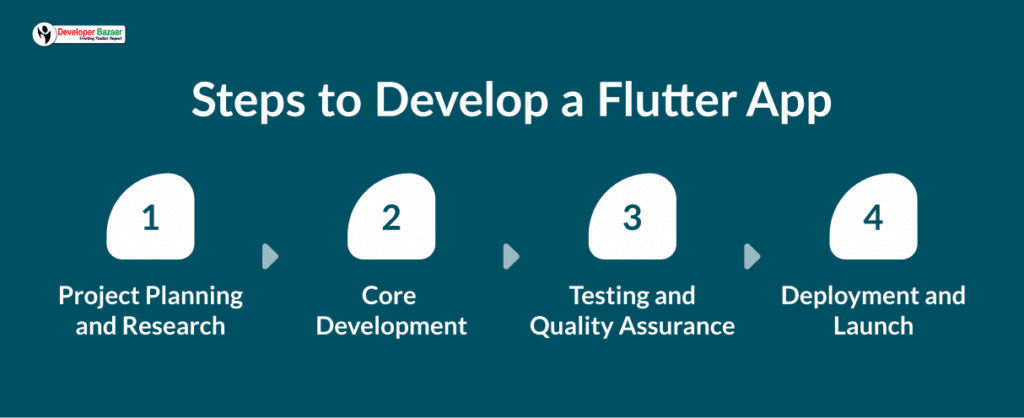
Phase 1: Project Planning and Research (2-4 weeks)
- Market Research and Competitive Analysis: Thorough market research identifies user needs, competitive landscape, and differentiation opportunities. This analysis informs feature prioritization and helps establish realistic project scope within budget constraints.
- Technical Architecture Planning: Architecture decisions significantly impact long-term development and app maintenance costs. Proper planning includes database design, API architecture, third-party service selection, and scalability considerations.
- UI/UX Design and Prototyping: Design phase includes user research, wireframing, visual design, and interactive prototyping. Investment in professional design reduces development iterations and ensures intuitive user experiences.
Phase 2: Core Development (8-16 weeks)
- Frontend Development Implementation: Flutter frontend development focuses on user interface implementation, navigation systems, responsive design, and platform-specific optimizations. Proper widget architecture ensures maintainable and scalable code.
- Backend Development and Integration: Backend development encompasses server setup, database implementation, API development, authentication systems, and security implementation. Cloud-native architectures provide scalability and cost efficiency.
- Third-Party Service Integration: External service integration includes payment processing, social media APIs, analytics platforms, and push notification systems. Proper integration planning prevents costly refactoring later in development.
Phase 3: Testing and Quality Assurance (2-4 weeks)
- Comprehensive Testing Strategy: Testing includes unit testing, integration testing, user acceptance testing, and performance optimization. Automated testing frameworks reduce long-term maintenance costs and improve code reliability.
- Cross-Platform Compatibility Verification: Flutter’s cross-platform nature requires testing across different devices, screen sizes, and operating system versions. Comprehensive testing ensures consistent user experiences and reduces post-launch support costs.
Phase 4: Deployment and Launch (1-2 weeks)
- App Store Optimization and Submission: App store submission requires compliance with platform guidelines, metadata optimization, and review process management. Professional submission services ensure faster approval and better market visibility.
- Production Infrastructure Setup: Production deployment includes cloud infrastructure configuration, monitoring system setup, backup procedures, and security implementation. Proper infrastructure planning prevents costly downtime and security issues.
Flutter vs Native App Cost Comparison
Understanding cost differences between Flutter and native development helps make informed technology decisions based on project requirements and budget constraints.
Flutter Cross-Platform Development
- Single Codebase: One development team creates applications for both iOS and Android
- Cost Range: $15,000-$150,000 depending on complexity
- Timeline: 2-10 months for complete development cycle
- Maintenance: Single codebase reduces ongoing maintenance costs by 40-60%
Native App Development (iOS + Android)
- Separate Codebases: Requires distinct iOS and Android development teams
- Cost Range: $25,000-$250,000 for comparable functionality
- Timeline: 4-18 months for complete development cycle
- Maintenance: Separate maintenance requirements for each platform
Detailed Cost Comparison Table
| Factor | Flutter Development | Native Development | Cost Difference |
|---|---|---|---|
| Simple App | $15,000-$30,000 | $25,000-$50,000 | 30-40% savings |
| Medium App | $30,000-$80,000 | $50,000-$140,000 | 35-45% savings |
| Complex App | $80,000-$150,000 | $140,000-$280,000 | 40-50% savings |
| Annual Maintenance | $5,000-$25,000 | $10,000-$45,000 | 50% savings |
Performance and Quality Considerations
Flutter Advantages
- Consistent user interface across platforms
- Single development team reduces coordination overhead
- Faster development cycles with hot reload functionality
- Lower long-term maintenance costs
Native Development Advantages
- Maximum performance optimization for each platform
- Full access to platform-specific features and APIs
- Optimal integration with device hardware capabilities
- Platform-specific user experience optimization
When to Choose Flutter vs Native?
Choose Flutter When
- Budget constraints require cost optimization
- Rapid development and market entry are priorities
- Consistent cross-platform experience is essential
- Long-term maintenance efficiency is important
Choose Native When
- Maximum performance is critical for app functionality
- Platform-specific features are core requirements
- Unlimited budget allows for premium development approaches
- Target audience strongly favors platform-specific experiences
Tips to Reduce Flutter App Development Costs
Implementing cost optimization strategies significantly reduces Flutter app development expenses without compromising quality or functionality. These proven approaches help maximize development budget efficiency.
Strategic Planning Optimizations
- Start with MVP (Minimum Viable Product): Developing an MVP first reduces initial investment by 50-70% while validating market demand. MVP development focuses on core functionality, allowing for iterative improvements based on user feedback and market response.
MVP benefits include:
- Faster time to market (2-3 months vs 6-12 months)
- Lower risk investment ($15,000-$30,000 vs $50,000-$150,000)
- Real user feedback guides future development priorities
- Easier investor attraction with working product demonstration
- Prioritize Features Based on User Value: Feature prioritization using frameworks like MoSCoW (Must have, Should have, Could have, Won't have) ensures budget allocation toward high-impact functionality. This approach prevents scope creep and maintains focus on essential user needs.
Technical Cost Optimizations
- Leverage Flutter's Widget Library: Flutter's extensive built-in widget library provides pre-built components for common UI elements. Utilizing these widgets instead of custom development reduces development time by 20-30% while maintaining professional appearance.
- Choose Open Source Solutions: Open source packages and libraries provide tested functionality at no licensing cost. Popular solutions include state management (Provider, Riverpod), networking (Dio), and database access (Floor, Hive) packages that accelerate development.
- Implement Progressive Feature Development: Phased development releases features gradually rather than building comprehensive functionality upfront. This approach spreads development costs over time while generating revenue earlier in the development cycle.
Team and Resource Optimizations
- Hybrid Team Structure: Combining senior developers for architecture and complex features with mid-level developers for standard implementation optimizes both cost and quality. This structure reduces average hourly rates while maintaining technical excellence.
- Fixed-Price Contract Negotiation: Fixed-price contracts provide budget certainty and encourage efficient development practices. These agreements work best with well-defined project scopes and clear deliverable specifications.
- Efficient Communication Protocols: Establishing clear communication channels and regular progress reviews prevents costly misunderstandings and scope changes. Weekly progress meetings and shared project management tools ensure alignment between client expectations and development progress.
Long-Term Cost Management
- Plan for Scalability from Day One: Scalable architecture prevents costly refactoring as user base grows. Cloud-native design patterns and microservices architecture enable efficient scaling without complete system overhauls.
- Implement Comprehensive Testing : Thorough testing during development prevents expensive post-launch bug fixes and user support issues. Quality assurance investment typically saves 3-5 times the cost in post-launch maintenance and support.
- Choose Reliable Technology Partners: Experienced Flutter development teams complete projects faster and with fewer issues than inexperienced developers. While hourly rates may be higher, total project costs often decrease due to improved efficiency and reduced revision cycles.
Conclusion
Flutter app development represents an exceptional opportunity for businesses seeking cost-effective, high-quality mobile applications in 2025. With development costs ranging from $15,000 for MVP versions to $150,000+ for enterprise solutions, Flutter provides significant savings compared to traditional native development while maintaining superior performance and user experience.
Key Investment Insights
- Cost Efficiency: Flutter development typically costs 40-60% less than equivalent native app development for both platforms, primarily due to unified codebase architecture and streamlined development processes.
- Timeline Advantages: Cross-platform development reduces time-to-market by 30-50%, enabling faster market entry and competitive positioning.
- Long-Term Savings: Single codebase maintenance reduces ongoing operational costs, with annual maintenance typically costing 15-20% of initial development investment.
Market Opportunity Summary
The cross-platform mobile development market continues expanding, with Flutter leading adoption among professional developers. Major companies including Google, BMW, and Alibaba demonstrate Flutter’s enterprise readiness and scalability for demanding applications.
Flutter’s growing ecosystem, Google’s continued investment, and expanding platform support (web, desktop, embedded) ensure long-term viability and potential for code reuse across multiple deployment targets.
Success Strategy Recommendations
Begin with comprehensive market research and clear feature prioritization to establish realistic budget expectations. Consider MVP development for initial market validation, then iterate based on user feedback and market response.
Choose development partners based on proven Flutter expertise rather than lowest cost alone. Experienced teams complete projects faster and with fewer revisions, often resulting in lower total project costs despite higher hourly rates.
Plan for scalability and future feature expansion during initial architecture design. Proper technical foundation prevents costly refactoring and enables efficient feature addition as business requirements evolve.
FAQs
1. How much does it cost to develop a basic Flutter app in 2025?
A basic Flutter MVP typically costs $15,000-$30,000 and takes 2-3 months to develop. This includes essential features like user registration, basic UI/UX, simple backend integration, and cross-platform deployment to both iOS and Android app stores.
2. What ongoing costs should I expect after launching my Flutter app?
Plan for 15-20% of your initial development cost annually for maintenance and updates. For a $50,000 app, expect $7,500-$10,000 yearly for hosting ($100-$500 monthly), security updates, OS compatibility updates, and minor feature enhancements. Additional costs include app store fees ($99 annually for Apple, $25 for Google Play).
3. How does Flutter development cost compare to native app development?
Flutter development typically costs less than native development for both iOS and Android platforms. A medium complexity Flutter app costing $50,000 would require approximately $85,000-$120,000 for equivalent native development due to separate development teams and duplicated effort.
4. What factors most significantly impact Flutter app development costs?
The primary cost factors include app complexity and feature set (30-40% of variation), development team location and expertise (25-35% of variation), project timeline requirements (10-20% of variation), and third-party integration complexity (15-25% of variation).
5. Can I reduce Flutter app development costs without compromising quality?
Yes, through strategic approaches including MVP development (reduces initial costs by 50-70%), leveraging Flutter’s built-in widgets and open-source packages, choosing experienced development teams that work efficiently, and implementing phased feature releases that spread costs over time.
6. How long does Flutter app development typically take?
Development timelines vary by complexity: MVP versions require 2-3 months, standard applications need 3-6 months, complex apps take 6-10 months, and enterprise solutions require 10+ months. Flutter’s cross-platform nature reduces timelines by 30-50% compared to separate native development.
7. What makes Flutter development more cost-effective than other frameworks?
Flutter’s single codebase architecture eliminates duplicate work across platforms, hot reload feature accelerates development cycles, comprehensive widget library reduces custom development needs, and strong community support provides extensive resources and documentation that improve development efficiency.
8. Should I choose Flutter or native development for my app project?
Choose Flutter when budget optimization, rapid development, and consistent cross-platform experience are priorities. Choose native development when maximum platform-specific performance, unlimited budget, or extensive platform-specific feature integration are requirements. Flutter serves 90% of mobile app projects effectively while providing significant cost advantages.

RM Mishra
Co-Founder
Developer Bazaar technologies
